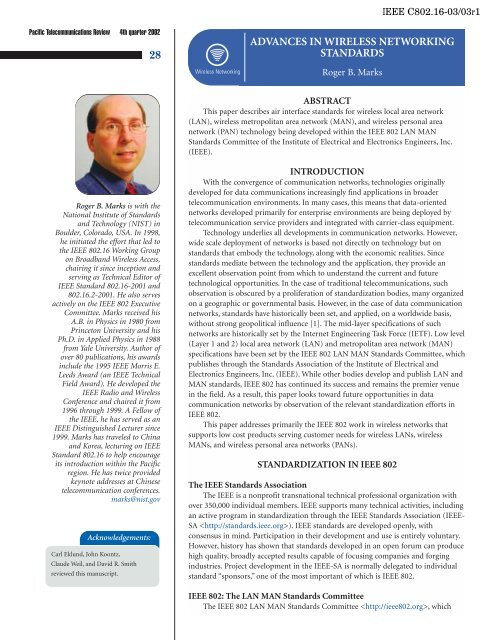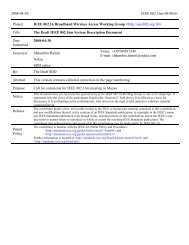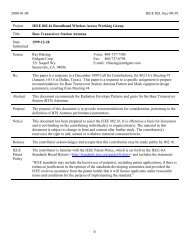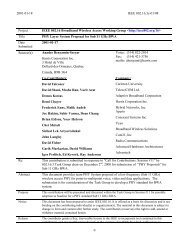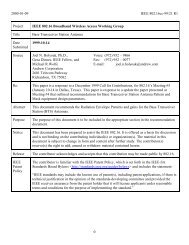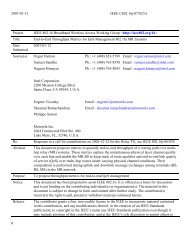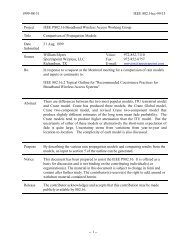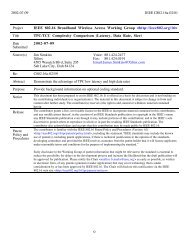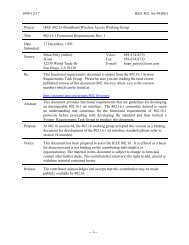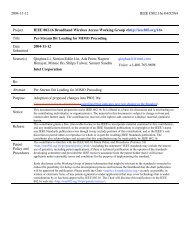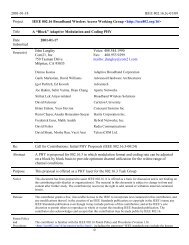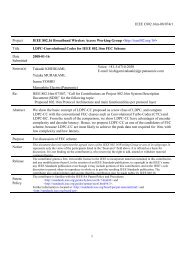Download - LMSC, LAN/MAN Standards Committee
Download - LMSC, LAN/MAN Standards Committee
Download - LMSC, LAN/MAN Standards Committee
Create successful ePaper yourself
Turn your PDF publications into a flip-book with our unique Google optimized e-Paper software.
IEEE C802.16-03/03r1<br />
Pacific Telecommunications Review 4th quarter 2002<br />
28<br />
Wireless Networking<br />
ADVANCES IN WIRELESS NETWORKING<br />
STANDARDS<br />
Roger B. Marks<br />
ABSTRACT<br />
This paper describes air interface standards for wireless local area network<br />
(<strong>LAN</strong>), wireless metropolitan area network (<strong>MAN</strong>), and wireless personal area<br />
network (PAN) technology being developed within the IEEE 802 <strong>LAN</strong> <strong>MAN</strong><br />
<strong>Standards</strong> <strong>Committee</strong> of the Institute of Electrical and Electronics Engineers, Inc.<br />
(IEEE).<br />
Roger B. Marks is with the<br />
National Institute of <strong>Standards</strong><br />
and Technology (NIST) in<br />
Boulder, Colorado, USA. In 1998,<br />
he initiated the effort that led to<br />
the IEEE 802.16 Working Group<br />
on Broadband Wireless Access,<br />
chairing it since inception and<br />
serving as Technical Editor of<br />
IEEE Standard 802.16-2001 and<br />
802.16.2-2001. He also serves<br />
actively on the IEEE 802 Executive<br />
<strong>Committee</strong>. Marks received his<br />
A.B. in Physics in 1980 from<br />
Princeton University and his<br />
Ph.D. in Applied Physics in 1988<br />
from Yale University. Author of<br />
over 80 publications, his awards<br />
include the 1995 IEEE Morris E.<br />
Leeds Award (an IEEE Technical<br />
Field Award). He developed the<br />
IEEE Radio and Wireless<br />
Conference and chaired it from<br />
1996 through 1999. A Fellow of<br />
the IEEE, he has served as an<br />
IEEE Distinguished Lecturer since<br />
1999. Marks has traveled to China<br />
and Korea, lecturing on IEEE<br />
Standard 802.16 to help encourage<br />
its introduction within the Pacific<br />
region. He has twice provided<br />
keynote addresses at Chinese<br />
telecommunication conferences.<br />
marks@nist.gov<br />
Acknowledgements:<br />
Carl Eklund, John Koontz,<br />
Claude Weil, and David R. Smith<br />
reviewed this manuscript.<br />
INTRODUCTION<br />
With the convergence of communication networks, technologies originally<br />
developed for data communications increasingly find applications in broader<br />
telecommunication environments. In many cases, this means that data-oriented<br />
networks developed primarily for enterprise environments are being deployed by<br />
telecommunication service providers and integrated with carrier-class equipment.<br />
Technology underlies all developments in communication networks. However,<br />
wide scale deployment of networks is based not directly on technology but on<br />
standards that embody the technology, along with the economic realities. Since<br />
standards mediate between the technology and the application, they provide an<br />
excellent observation point from which to understand the current and future<br />
technological opportunities. In the case of traditional telecommunications, such<br />
observation is obscured by a proliferation of standardization bodies, many organized<br />
on a geographic or governmental basis. However, in the case of data communication<br />
networks, standards have historically been set, and applied, on a worldwide basis,<br />
without strong geopolitical influence [1]. The mid-layer specifications of such<br />
networks are historically set by the Internet Engineering Task Force (IETF). Low level<br />
(Layer 1 and 2) local area network (<strong>LAN</strong>) and metropolitan area network (<strong>MAN</strong>)<br />
specifications have been set by the IEEE 802 <strong>LAN</strong> <strong>MAN</strong> <strong>Standards</strong> <strong>Committee</strong>, which<br />
publishes through the <strong>Standards</strong> Association of the Institute of Electrical and<br />
Electronics Engineers, Inc. (IEEE). While other bodies develop and publish <strong>LAN</strong> and<br />
<strong>MAN</strong> standards, IEEE 802 has continued its success and remains the premier venue<br />
in the field. As a result, this paper looks toward future opportunities in data<br />
communication networks by observation of the relevant standardization efforts in<br />
IEEE 802.<br />
This paper addresses primarily the IEEE 802 work in wireless networks that<br />
supports low cost products serving customer needs for wireless <strong>LAN</strong>s, wireless<br />
<strong>MAN</strong>s, and wireless personal area networks (PANs).<br />
STANDARDIZATION IN IEEE 802<br />
The IEEE <strong>Standards</strong> Association<br />
The IEEE is a nonprofit transnational technical professional organization with<br />
over 350,000 individual members. IEEE supports many technical activities, including<br />
an active program in standardization through the IEEE <strong>Standards</strong> Association (IEEE-<br />
SA ). IEEE standards are developed openly, with<br />
consensus in mind. Participation in their development and use is entirely voluntary.<br />
However, history has shown that standards developed in an open forum can produce<br />
high quality, broadly accepted results capable of focusing companies and forging<br />
industries. Project development in the IEEE-SA is normally delegated to individual<br />
standard “sponsors,” one of the most important of which is IEEE 802.<br />
IEEE 802: The <strong>LAN</strong> <strong>MAN</strong> <strong>Standards</strong> <strong>Committee</strong><br />
The IEEE 802 <strong>LAN</strong> <strong>MAN</strong> <strong>Standards</strong> <strong>Committee</strong> , which
first met in 1980, develops and maintains standards at the physical layer (PHY) and<br />
medium access control sublayer (MAC), each of which fits under a common logical<br />
link control sublayer (LLC), as defined in IEEE Standard 802® [2]. Together, these<br />
make up the two lowest layers of the Open Systems Interconnection (OSI) sevenlayer<br />
model for data networks. IEEE 802 holds week-long plenary sessions three<br />
times a year. In addition, most of its constituent Working Groups hold interim<br />
sessions between each of these plenary sessions.<br />
Historically, IEEE 802 has been best known for IEEE Standard 802.3, informally<br />
known as Ethernet, which is so successful that it is virtually synonymous with wired<br />
<strong>LAN</strong>. Like all successful 802 standards, however, IEEE 802.3 continuously evolves,<br />
migrating from shared coaxial cabling to twisted-pair lines supporting data rates of 1<br />
Gbit/s. The year 2002 saw the approval of IEEE Standard 802.3ae, which specifies 10<br />
Gbit/s Ethernet over optical fiber and provides for linking Ethernet <strong>LAN</strong>s to <strong>MAN</strong>s<br />
and wide area networks (WANs). The current focus of 802.3 is the project “Ethernet<br />
in the First Mile”, which aims to support high speed access to businesses and homes,<br />
with minimal protocol conversion, over suitable twisted-pair copper cabling or<br />
passive optical networks. IEEE 802’s portfolio of active projects in the cabled realm<br />
grew in late 2000 with the approval of the IEEE 802.17 Working Group on Resilient<br />
Packet Rings.<br />
While Ethernet has been its greatest success, IEEE 802 is now the home of a<br />
number of wireless network standardization projects that take advantage of its highly<br />
successful development system. Before continuing with detailed discussion of the<br />
IEEE 802 wireless standards program, it will be useful to overview this process.<br />
The IEEE 802 Standardization Process<br />
The IEEE 802 process [3] is designed for quick development of standards with<br />
broad consensus. The demand for consensus helps to ensure that standards are<br />
technically refined and meet market needs. The essence of the process is a two stage<br />
balloting system, each with multiple rounds, that seeks not only to confirm<br />
consensus but also to generate critical comment. It is sometimes said in IEEE 802<br />
that the purpose of balloting is not to approve the draft standard but to improve it.<br />
Experience has shown that the IEEE 802 process is extremely effective at engaging a<br />
wide variety of interested parties, fostering comments, and implementing<br />
constructive changes. As a result, 802 drafts are refined again and again. By the time<br />
a draft is ready for approval, users have solid confidence in it. Yet, with careful<br />
attention and the will of the developers, it is possible to drive the draft through the<br />
system within a reasonable time.<br />
Pacific Telecommunications Review 4th quarter 2002<br />
29<br />
Open Systems Interconnection (OSI)<br />
THE IEEE 802 WIRELESS STANDARDS PROGRAM<br />
The IEEE 802 wireless standards program [4] comprises three working groups:<br />
The IEEE 802.11 Working Group develops the IEEE 802.11 standards for<br />
Wireless Local Area Networks (Wireless <strong>LAN</strong>)<br />
The IEEE 802.15 Working Group develops the IEEE 802.15 standards for<br />
Wireless Personal Area Networks (Wireless PAN)<br />
The IEEE 802.16 Working Group on Broadband Wireless Access develops the<br />
IEEE 802.16 standards for Wireless Metropolitan Area Networks<br />
(Wireless<strong>MAN</strong>).<br />
In addition, two Technical Advisory Groups (TAGs) help coordinate activities:<br />
The IEEE 802.18 Regulatory TAG<br />
The IEEE 802.19 Coexistence TAG
Pacific Telecommunications Review 4th quarter 2002<br />
"one" data bit<br />
10-chip code<br />
word for each<br />
"one" data bit<br />
Same chip<br />
code word<br />
but inverted<br />
for "zero"<br />
data bit<br />
"zero" data bit<br />
30<br />
Original DSSS System<br />
“Applications of<br />
IEEE 802.11<br />
flourished with<br />
the emergence of<br />
products based on<br />
802.11b. There<br />
are now an<br />
estimated 30<br />
million 802.11<br />
users...”<br />
The following sections summarize the status and technology of the projects in<br />
the IEEE 802 wireless standards program.<br />
IEEE 802.11 Wireless Local Area Networks (Wireless <strong>LAN</strong>s)<br />
The IEEE 802.11 Working Group for Wireless Local Area Networks<br />
initiated the IEEE 802 wireless effort and published its base<br />
standard in 1997. A revised 1999 edition was also published as international standard<br />
ISO/IEC 8802-11. The base standard includes three PHY specifications, but one<br />
(infrared) has been little used. The other two obey spread spectrum rules laid down<br />
for 2.4 GHz license exempt uses in the U.S. that was later emulated in many other<br />
countries.<br />
Two important PHY amendments (802.11a and 802.11b) were also published in<br />
1999. IEEE 802.11b specifies a direct sequence spread-spectrum (DSSS) system with a<br />
peak data rate of 11 Mbit/s. Lower rates are available for poor links, with dynamic rate<br />
switching rules specified. Typical range is on the order of 100 m. Since this mode is a<br />
backward compatible extension of the original DSSS system, control information is<br />
transmitted at the common 1 Mbit/s rate. This is one reason that actual throughput is<br />
less than ideal. The channel bandwidth is about 20 MHz, so that the typical North<br />
American and European frequency allocations (2.4 - 2.4835 GHz) provide for three<br />
non-overlapping channels (though overlapping channels are defined). A smaller<br />
Japanese allocation is noted in the standard. These devices are used in many<br />
countries, with varying spectrum allocations and power limits. IEEE Standard<br />
802.11d provides for the specification of a “Country Information Element” that allows<br />
a station to identify the regulatory domain in which it is located and to configure its<br />
PHY accordingly.<br />
Interoperability testing is critical to supplement standards. In the case of 802.11,<br />
the Wireless Ethernet Compatibility Alliance was created to develop interoperability<br />
tests and brand the interoperable products with the trademark Wi-Fi. Wi-Fi has<br />
played a key role in the success of 802.11b, and nearly all commercial 802.11b<br />
products are Wi-Fi certified. The Wi-Fi procedures test some but not all 802.11b<br />
options. The options that are not tested are rarely implemented in mass market<br />
products.<br />
Applications of IEEE 802.11 flourished with the emergence of products based on<br />
802.11b. There are now an estimated 30 million 802.11 users, with annual growth of<br />
over 20 million units. Many manufacturers initially targeted enterprises that wished to<br />
reduce the cabling costs associated with Ethernet. However, 802.11b products came<br />
along at the same time as two other important developments: (1) powerful laptop<br />
computers with PCMCIA slots, and (2) widespread broadband network deployments<br />
to homes and small businesses. The combination is quite powerful: it allows a user to<br />
have instant broadband access at the fingertips throughout an office area. Some<br />
enterprising computer manufacturers began to market this package to the home user,<br />
lowering prices accordingly. Sales grew and prices fell. User terminals are available for<br />
about US$50, and feature-enhanced access points (base stations) for around US$100.<br />
With millions of 802.11b-equipped portable computers interoperable with<br />
millions of access points, it became inevitable that they would begin to interact with<br />
access points that they did not own. For example, for many years, IEEE 802 standards<br />
meetings have supported dozens, and then hundreds, of users accessing local servers,<br />
and the Internet, on wireless <strong>LAN</strong>s. Many other conferences have adopted this<br />
concept, which was soon extended to provide “hot spots” in other public or semipublic<br />
places–classrooms, hotels, airports, cafes, campuses, etc.In contrast to the<br />
vision of mobile data provided by third generation cellular telephone networks, these<br />
hot spots take advantage of the many opportunities to provide data at high rates to<br />
people who are relatively sedentary–normally at a desk or table–with low cost<br />
equipment that they already own for use in their private networks, and with freely<br />
available spectrum.<br />
Many of the initial 802.11b public space deployments were provided purely as a<br />
service to the user. However, some entrepreneurs began seeing commercial
networking opportunities. Companies began creating branded clusters of hot spots,<br />
across a city or in a group of hotels, airports, coffee shops, or perhaps automobile<br />
filling stations, with a single account used to pay the usage fee at all nodes. Currently,<br />
companies are trying to consolidate these systems and give the user an easy log-in<br />
procedure at more locations. It is reported that Europe leads in this field [5], which is<br />
somewhat surprising in light of Europe’s strong push for third generation cellular<br />
systems and of the HIPER<strong>LAN</strong>/2 standard, an alternative wireless <strong>LAN</strong> specification<br />
created by the European Telecommunications <strong>Standards</strong> Institute but which has<br />
not found much success.<br />
While much of the commercial development aims to address<br />
transitory users, wireless <strong>LAN</strong>s have also become popular with<br />
both amateur and commercial wireless Internet service<br />
providers (WISPs). Typically, these systems provide<br />
continuous broadband access to users in a home. The <strong>LAN</strong>s<br />
operate in outdoor space, often with directional antennas to extend<br />
the range. These systems have shown great initial success, but some<br />
potential technical hurdles remain, as discussed below.<br />
IEEE Standard 802.11 includes both ad hoc networks (with<br />
terminal devices only) and infrastructure networks, which connect<br />
mobile stations to access points that bridge to a wired <strong>LAN</strong>. The<br />
latter are more popular and are the focus here.<br />
The essence of 802.11 is its MAC, which supports all<br />
of its PHY specifications. The primary access method, denoted the<br />
distributed coordination function (DCF), is based on carriersense<br />
multiple access with collision avoidance<br />
(CSMA/CA). CSMA/CA, like Ethernet, is a listen-beforetalk<br />
protocol, with specific deferral procedures used<br />
when the medium is busy. However, collision detection,<br />
which minimizes the effects of collisions when used in Ethernet,<br />
is essentially impossible in the wireless case because of the great<br />
disparity in signal levels. Furthermore, most units are half-duplex<br />
and therefore cannot sense while transmitting. Even carrier-sensing<br />
Internet<br />
as a means of spotting a transmission opportunity is unreliable in the wireless case<br />
because of the “hidden terminal” problem, in which the receiver may be within range<br />
of several transmitters that are unable to hear each other. Therefore, 802.11 includes<br />
a request-to-send/clear-to-send (RTS/CTS) protocol which, in essence, notifies other<br />
users that the medium is expected to be busy and therefore provides a “virtual carrier<br />
sense.” A station defers transmission in response to either its physical or its virtual<br />
carrier sense.<br />
The RTS/CTS mechanism is effective at addressing the hidden terminal problem,<br />
at least with a moderate number of terminals hidden, and with some cost in<br />
overhead. However, RTS/CTS is challenged in the WISP environment with<br />
directional subscriber antennas. In this case, virtually all of the terminals are hidden<br />
from each other. Also, while responding to RTS/CTS is mandatory, generation of RTS<br />
is optional, so not all Wi-Fi radios support it. If the terminals do not generate RTS,<br />
the mechanism does not function.<br />
The 802.11 Working Group is currently engaged in many activities to upgrade<br />
the standard to address some specific limitations and problems. In particular:<br />
Quality of Service (QoS)<br />
The contention-based 802.11 MAC, based on the DCF, was not designed for<br />
time-critical applications, such as voice, video, and games. The standard<br />
specifies an alternative Point Coordination Function (PCF), which works in<br />
conjunction with the DCF to provide scheduled service. However, the PCF has<br />
not been widely implemented. A project known as 802.11e has worked for<br />
several years to enhance the MAC for time-critical services. The problem<br />
remains challenging.<br />
Home Office<br />
Den<br />
Pacific Telecommunications Review 4th quarter 2002<br />
31<br />
Bedroom<br />
Wireless Local Area Network<br />
inside a home<br />
“…wireless <strong>LAN</strong>s<br />
have also become<br />
popular with both<br />
amateur and<br />
commercial<br />
wireless Internet<br />
service providers<br />
(WISPs).”
Pacific Telecommunications Review 4th quarter 2002<br />
32<br />
“Bluetooth<br />
retains signicant<br />
advantages<br />
in power<br />
consumption,<br />
and its support<br />
for voice is a<br />
significant<br />
feature.”<br />
Security<br />
IEEE Standard 802.11 specifies a security protocol known as Wired Equivalent<br />
Privacy (WEP). WEP was designed to “protect authorized users of a wireless<br />
<strong>LAN</strong> from casual eavesdropping.” Weaknesses in WEP have been discovered,<br />
and successful attack algorithms are available [6]. Project 802.11i is developing<br />
more reliable standard security protocols. In the meantime, external security,<br />
beyond the wireless link, may be required for sensitive applications.<br />
Interworking<br />
The IEEE 802.11 Working Group, along with other standards bodies, has begun<br />
discussions on developing standard interworking by which devices outfitted<br />
with both wireless <strong>LAN</strong> and cellular telephone radios can readily switch<br />
between the two based on availability. In November 2002, discussion began<br />
within 802 on an even broader approach: to develop a standard 802 handoff<br />
interface that would include all 802 wireless devices in a common approach.<br />
Higher Data Rate<br />
One solution to the data-rate limitations of 802.11b is already a standard.<br />
Devices based on IEEE 802.11a, which was published in 1999, offer, in principle,<br />
rates up to 54 Mbit/s and are now available at moderate cost (under US$100).<br />
This technology is used in license-exempt 5 GHz bands (5.15–5.25, 5.25–5.35<br />
and 5.725–5.825 GHz in the U.S.). Channel bandwidths are similar to those of<br />
802.11b, and channels are defined with 20 MHz spacing. Orthogonal frequencydivision<br />
multiplexing (OFDM) is used, with 52 subcarriers. A current project,<br />
802.11g, is enhancing the data rates within the 2.4 GHz band. The current draft<br />
is based on the OFDM PHY in 802.11a, with similar data-rate capability.<br />
Wireless Personal Area Network<br />
IEEE 802.15 Wireless Personal Area Networks (Wireless PANs)<br />
The IEEE 802.15 Working Group for Wireless Personal Area Networks<br />
develops standards for Wireless PANs to link portable<br />
devices. The work is exclusively in unlicensed bands (only in the 2.4 GHz band and<br />
below, to this point) with ranges up to 10 m. Low power consumption, small size,<br />
and low cost are primary considerations.<br />
The 802.15 Working Group’s first activity was to develop a standard derived<br />
from Bluetooth Specification Version 1.1. This activity was<br />
completed with the June 2002 publication of IEEE Standard<br />
802.15.1. Bluetooth is a “cable replacement” technology supporting<br />
low cost wireless communication between computers, mobile<br />
telephones, printers, etc. The networking is ad hoc and based on<br />
small temporary “piconets”. The specification supports data at rates<br />
up to 721 kbit/s, as well as three voice channels, and targets low<br />
power consumption (less than 0.1 W during transmission). The<br />
primary initial applications have been in cellular telephones and<br />
handheld computers, with Bluetooth providing a wireless link to<br />
headsets and to computers for synchronization. Automotive<br />
environments seem to be a growth area. Many analysts have<br />
claimed that, with the wide scale deployment of 802.11, Bluetooth<br />
has lost its cost advantage and, with its much lower data rate,<br />
cannot compete with 802.11. However, Bluetooth retains significant advantages in<br />
power consumption, and its support for voice is a significant feature. Many<br />
prognosticators still expect a large role for Bluetooth products in its niche.<br />
Separately, the 802.15 Working Group is developing a high rate wireless PAN<br />
under IEEE Project 802.15.3. The draft standard in ballot describes a system that<br />
supports up to 55 Mbit/s for applications such as digital imaging and multimedia.<br />
The MAC is based on temporary piconets but differs from that of 802.15.1. A study<br />
is already underway regarding an enhanced PHY specification that would support at
least 110 Mbit/s. It appears likely that, if the work proceeds, the enhanced PHY will<br />
be based on ultra-wideband communications.<br />
Finally, the 802.15 Working Group is developing yet another independent<br />
wireless PAN in Project 802.15.4. This will specify a low rate PAN supporting rates<br />
up to 250 kbit/s with very low power consumption (for battery life on the order of<br />
months or years) and low complexity (targeting costs of US$2 per radio).<br />
Applications are expected in sensors, toys, and location tracking. A draft standard is<br />
in ballot.<br />
IEEE 802.16 Wireless Metropolitan Area Networks (Wireless <strong>MAN</strong>s)<br />
The IEEE Working Group 802.16 on Broadband Wireless Access (BWA)<br />
has developed the Wireless<strong>MAN</strong> air interface standard<br />
to support the development and deployment of wireless metropolitan area networks.<br />
The Working Group is primarily addressing applications of wireless technology to<br />
link commercial and residential buildings to high rate core networks and thereby<br />
provide access to those networks. This link is sometimes known colloquially as the<br />
“last mile.”<br />
The Working Group’s first air interface project was completed with the April<br />
2002 publication of IEEE Standard 802.16: Air Interface for Fixed Broadband Wireless<br />
Access Systems.As specified in this standard [7], a wireless metropolitan area network<br />
(<strong>MAN</strong>) provides network access to buildings through exterior antennas<br />
communicating with central radio base stations (BSs) in a point-to-multipoint<br />
topology. The wireless <strong>MAN</strong> offers an alternative to cabled access networks, such as<br />
fiber-optic links, coaxial systems using cable modems, and digital subscriber line<br />
(DSL) links. Because wireless systems have the capacity to address broad geographic<br />
areas without the costly infrastructure development required in deploying cable links<br />
to individual sites, the technology may prove less expensive to deploy and may lead<br />
to more ubiquitous broadband access.<br />
In this scenario, with Wireless<strong>MAN</strong> technology bringing the network to a<br />
building, users inside the building will connect to it with conventional in building<br />
networks such as, for data, Ethernet (IEEE 802.3) or wireless local area networks<br />
(IEEE 802.11). However, the fundamental design of the standard may eventually<br />
allow for the efficient extension of the Wireless<strong>MAN</strong> networking protocols directly to<br />
the individual user. For instance, a central BS may someday be exchanging medium<br />
access control (MAC) protocol data with an individual laptop computer in a home.<br />
The links from the BS to the home receiver and from the home receiver to the laptop<br />
would likely use quite different physical layers, but design of the Wireless<strong>MAN</strong> MAC<br />
could accommodate such a connection with full QoS. The standard has already<br />
begun to evolve to support nomadic and increasingly mobile users.<br />
The 802.16 MAC is QoS sensitive and connection oriented, with a base station<br />
allocating bandwidth according to terminal requests. Access and bandwidth<br />
allocation algorithms accommodate hundreds of terminals per channel, with<br />
terminals that may be shared by multiple end users. The request grant mechanism is<br />
designed to maintain its efficiency when presented with multiple connections per<br />
terminal, multiple QoS levels per terminal, and a large number of statistically<br />
multiplexed users. It takes advantage of a wide variety of request mechanisms,<br />
balancing the stability of contentionless access with the efficiency of contention<br />
oriented access. While extensive bandwidth allocation and QoS mechanisms are<br />
provided, the details of scheduling and reservation management are left<br />
unstandardized and provide an important mechanism for vendors to differentiate<br />
their equipment.<br />
The 802.16 MAC supports services including Internet Protocol (IP) Versions 4<br />
and 6, packetized voice-over-IP (VoIP), Ethernet, and Asynchronous Transfer Mode<br />
(ATM). Features such as payload header suppression, packing and fragmentation<br />
help to carry traffic in a form that is often more efficient than the original transport<br />
mechanism.<br />
Pacific Telecommunications Review 4th quarter 2002<br />
33<br />
“The wireless<br />
<strong>MAN</strong>…may<br />
prove less<br />
expensive to<br />
deploy and may<br />
lead to more<br />
ubiquitous<br />
broadband<br />
access.”
Pacific Telecommunications Review 4th quarter 2002<br />
34<br />
“IEEE Standard<br />
802.16 was<br />
designed to evolve<br />
as a set of air<br />
interfaces based<br />
on a common<br />
MAC protocol<br />
but with<br />
physical layer<br />
specifications<br />
dependent on the<br />
spectrum of use<br />
and the associated<br />
regulations.”<br />
Along with the fundamental task of allocating bandwidth and transporting data,<br />
the MAC includes a privacy sublayer that provides reliable key exchange and<br />
encryption for data privacy and provides authentication of network access and<br />
connection establishment to avoid theft of service.<br />
IEEE Standard 802.16 was designed to evolve as a set of air interfaces based on a<br />
common MAC protocol but with physical layer specifications dependent on the<br />
spectrum of use and the associated regulations. The published base standard<br />
addresses frequencies from 10 to 66 GHz, where extensive spectrum is currently<br />
available worldwide but at which the short wavelengths introduce significant<br />
challenges, including propagation that is essentially limited to line-of-sight. The 10-<br />
66 GHz air interface is designated “Wireless<strong>MAN</strong>-SC” because it uses single carrier<br />
modulation. The base station basically transmits a time-division multiplexed (TDM)<br />
signal, with individual subscriber stations allocated time slots serially. Access in the<br />
uplink direction is by time division multiple access (TDMA). Both time division<br />
duplexing (TDD) and frequency division duplexing (FDD) are handled in a<br />
common burst fashion. Half-duplex FDD subscriber stations, which may be less<br />
expensive since they do not simultaneously transmit and receive, are easily supported<br />
in this framework. Both the TDD and FDD alternatives support adaptive burst<br />
profiles in which modulation and coding options are dynamically assigned on a<br />
burst-by-burst basis.<br />
IEEE Project 802.16a is developing a draft (with completion expected in 2002)<br />
addressing frequencies in the 2-11 GHz band, including both licensed and license<br />
exempt bands. Compared to the higher frequencies, such bands offer the<br />
opportunity to reach many more customers less expensively, though at generally<br />
lower data rates. This suggests that such services will be oriented toward individual<br />
homes or small-to-medium sized enterprises. Design of the 2-11 GHz physical layer<br />
is driven by the need for non-line-of-sight (NLOS) operation. This is essential to<br />
support residential applications since rooftops may be too low for a clear sight line to<br />
a BS antenna, possibly due to obstruction by trees. Therefore, significant multipath<br />
propagation must be expected. Furthermore, outdoor mounted antennas are<br />
expensive due to both hardware and installation costs.<br />
The current draft specifies that systems implement one of three air interface<br />
specifications, each of which provides for interoperability:<br />
Wireless<strong>MAN</strong>-SCa: This uses a single-carrier modulation format.<br />
Wireless<strong>MAN</strong>-OFDM: This uses orthogonal frequency division multiplexing<br />
with a 256-point transform. Access is by TDMA.<br />
Wireless<strong>MAN</strong>-OFDMA: This uses orthogonal frequency division multiple<br />
access with a 2048-point transform. In this system, multiple access is provided<br />
by addressing a subset of the multiple carriers to individual receivers.<br />
Because of the propagation requirements, the use of advanced antenna systems<br />
is supported.<br />
To accommodate the more demanding physical environment and different<br />
service requirements found at frequencies between 2 and 11 GHz, the 802.16a<br />
project upgrades the MAC to provide automatic repeat request (ARQ). Also, an<br />
optional mesh topology is defined to expand the basic point-to-multipoint<br />
architecture.<br />
As 802.16a nears completion, the 802.16 Working Group is turning its attention<br />
to enhancing the standard, primarily by adding support for mobile user devices. The<br />
Working Group began addressing this subject in March 2002.<br />
In order to assist the successful transition from standardization to wide scale<br />
deployment, the Working Group is also placing a great deal of attention on<br />
compliance and interoperability. The group has begun rapidly developing test
documentation. The Worldwide Interoperability Microwave Access (WiMAX) Forum<br />
, an industry consortium, has arisen to help define and<br />
carry out interoperability assurance tests.<br />
CONCLUSION<br />
The open, global consensus process, coupled with a history of success, has made<br />
IEEE 802 the dominant venue for the development of low level networking<br />
standards. Out of 802 are arising the fundamental standards for wireless <strong>LAN</strong>s,<br />
PANs, and <strong>MAN</strong>s that will define the shape of future networking.<br />
Pacific Telecommunications Review 4th quarter 2002<br />
35<br />
References:<br />
[1] R. B. Marks and R. E. Hebner, “Government Activity to Increase Benefits from the Global <strong>Standards</strong> System,” 2001<br />
IEEE Conference on <strong>Standards</strong> and Innovation in Information Technology (Boulder, Colorado, USA), pp. 183-190,<br />
3-5 October 2001.<br />
[2] IEEE <strong>Standards</strong>, including all those mentioned here, are available from the IEEE .<br />
Many may be downloaded without cost.<br />
[3] R. B. Marks, “IEEE Standardization for the Wireless Engineer,” IEEE Microwave Magazine,June 2001, pp. 16-26.<br />
[4] R. B. Marks, I. C. Gifford, and B. O’Hara, “<strong>Standards</strong> in IEEE 802 Unleash the Wireless Internet,” IEEE Microwave<br />
Magazine,June 2001, pp. 46-56.<br />
[5] J. Blau, “Wi-Fi Hotspot Networks Sprout Like Mushrooms,” IEEE Spectrum,Sept. 2002. pp. 18-20.<br />
[6]T. Karygiannis and L. Owens, DRAFT Wireless Network Security: 802.11, Bluetooth and Handheld Devices,NIST<br />
Special Publication 800-48, July 2002.<br />
[7] C. Eklund, R. B. Marks, K. L. Stanwood, and S. Wang, “IEEE Standard 802.16: A Technical Overview of the<br />
Wireless<strong>MAN</strong> Air Interface for Broadband Wireless Access,” IEEE Communications Magazine,June 2002, pp. 98-107.


